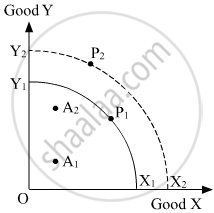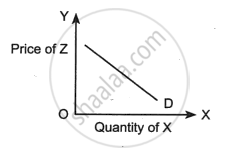Advertisements
Advertisements
प्रश्न
Demand curve and Supply curve.
उत्तर
| Point | Demand Curve | Supply Curve |
| 1. Meaning | Demand curve is the graphical representation of a given demand schedule. It shows variations in the quantity demanded in response to change in price. | Supply curve is the graphical representation of a given en supple schedule. It shows the variations in the quantity supplied in response to change in price. |
| 2. Price Relationship | There exist an inverse relationship between the quantity demanded and the price of a given commodity. | There exist an direct relationship between the quantity supplied and the price of a given commodity |
| 3. Slope of the curve | The demand curve slopes downwards form the left to right. It has negative slope. | The supply curve slopes upwards from left to right. It has positive slope. |
| 4. Behaviour Relationship | The demand curve indicates buyers’ behaviour in response to change in price. | The supply curve indicates sellers’ behaviour in response to change in price. |
APPEARS IN
संबंधित प्रश्न
Demand for necessaries is................
(elastic / inelastic / infinitely elastic / unitary elastic)
Demand for perishable goods is inelastic.
Compare inelastic demand with perfectly inelastic demand.
Explain the problem of what to produce.
Demand deposits include (choose the correct alternative)
(a) Saving account deposits and fixed deposits
(b) Saving account deposits and current account deposits
(c) Current account deposits and fixed deposits
(d) All types of deposits
When the income of the consumer falls the impact on a price-demand curve of an inferior good is: (choose the correct alternative)
a. Shifts to the right.
b. Shifts of the left.
c. There is upward movement along the curve.
d. There is downward movement along the curve
State the factors leading to fall in demand by an individual consumer
Demand for electricity is elastic.
State whether the following statement is True or False :
Demand for necessary goods is inelastic.
State with reason. Whether you ‘agree’ or ‘disagree’ with the following statement:
There are no exceptions to the law of Demand.
Fill in the blank using proper alternatives given in the bracket:
Demand for salt is ...............
Answer the following question.
State and explain the law of demand.
Fill in the blanks using proper alternatives given in the brackets.
Demand for car and petrol is ____________ de
Write whether the following statement is True or False:
Demand curve has a positive slope.
(b) less elastic demand
(c) zero elastic demand
(d) unitary elastic demand
Write Explanatory answer.
State and explain the law of demand with its exception.
Fill in the blank with appropriate alternatives given below:
When the price of petrol goes up, demand of cars will ___________.
Fill in the blank with appropriate alternatives given below:
Indirect demand is also known as _____________ demand.
State whether the following statement is TRUE and FALSE
Demand curve slopes upward from left to right.
Define or explain the following concept:
Derived demand
Give reason or explain the following statement.
Demand for factors of production is derived demand.
Fill in the blank using appropriate alternatives given below
The demand for perishable goods is _______
Answer the following question.
Discuss the relationship between the income of the consumer and demand for a commodity with respect to normal goods, inferior goods, and necessities.
Distinguish between substitute goods and complementary goods, with examples.
Choose the correct answer from given options
In the given figure X1Y1 and X2Y2 are Production Possibility Curves in two different periods T1 and T2 respectively for Good X and Good Y. A1 and A2 represent actual outputs and P1 and P2 represent potential outputs respectively in the two times periods.

The change in actual output of Goods X and Y over the two periods would be represented by a movement from __________.
Answer the following question:
Elaborate the law of demand, with the help of a hypothetical schedule.
In case of ______ supply curve is a vertical straight line parallel to Y-axis.
Which of the following points relates to the transaction demand for money?
There is a sudden change in climatic conditions resulting in hot weather. Assuming no change in the price of the cold drinks, it will lead to ______
Which of the following points are related to the 'Paradox of Thrift'?
Identify the correct pair of items from the following Columns I and II:
| Column I | Column II |
| (1) Utility | (a) Bread and butter |
| (2) Normal Goods | (b) Rise in price |
| (3) Contraction in demand | (c) Capacity of a commodity to satisfy human wants. |
| (4) Complementary goods | (d) Positively related |
Identify the correct pair of items from the following Columns I and II:
| Column I | Column II |
| (1) Budget Line | (a) Normal goods |
| (2) Bajra | (b) Inferior goods |
| (3) Consumer equilibrium | (c) Luxurious goods |
| (4) Elastic Demand | (d) M = Px*x + py*y |
What will be the effect on equilibrium price and equilibrium quantity when income increases in case of normal goods?
Area under MC curve is equal to:
Which of the following can cause an increase in demand:
Which of the following have elastic demand?
Identify the two cost curves which start from the same point on the Y-axis.
Aggregate demand can be decreased by:
Which of the following statements is correct with respect to the correction of Excess Demand?
Which of the following is correct?
Which of the following statements is true?
Which of the following statements is false?
Read the following news report and answer the Q.97-Q.100 on the basis of the same:
The quantity of a commodity that a consumer is willing to buy and is able to afford, given the prices of goods and the consumer's tastes and preferences is called demand for the commodity. Whenever one or more of these variables change, the quantity of the good Chosen by the consumer is likely to change as well. The relation between the consumer's optimal choice of the quantity of a good and its price is very important and this relation is called the demand function. Thus, the consumer's demand function for a good gives the amount of the good that the consumer chooses at different levels of its price when the other things remain unchanged.
Assertion: The income of the consumers remains unchanged
Reason: Commodity should be a normal good.
Select the correct alternative from the following.
Which of the following is the reason behind the downward slope of demand option?
Read the case study and answer the questions 97 to 100:
The Coca-Cola Company is an American multinational beverage company, with its headquarters in Atlanta, Georgia. The first company that conducted its operation in the soft drink industry was Coca-Cola. It is the world's largest non-alcoholic beverage company serving more than 1.8 billion consumers daily in more than 200 countries. It has a portfolio of more than 3,500 (more than 800 no or low-calorie) products. However, the company is best known for its flagship product Coca-Cola which was originally intended to be a patented medicine invented in 1886 by pharmacist John Smith Pemberton in Columbus, Georgia. The Coca-Cola products can be termed as normal goods and in August 2019 Coca-Cola introduced a new product into the market, that is, zero sugar where the demand has increased for the product in the market.
According to the council of the Australian Food Technology Association and Institute of Food Science and Technology, the Australian nonalcoholic beverages industry has been growing steadily, with a 2.3 percent increase in overall production in the year 2000 which amounts to 2.25 billion liters. However, in the re~ent years, sales of customary carbonated soft drinks have dropped as more and more customers become health conscious and move away from high-calorie sugary drinks. Soft Carbonated drinks. and other alcohol-free beverage manufacturers have also sensed the effects of intensifying competition from private-label soft drink makers. Nevertheless, sales of greater value energy and sports drinks have driven profit generation in the industry.
The demand. for coca-cola has ______
Read the case study and answer the questions 97 to 100:
The Coca-Cola Company is an American multinational beverage company, with its headquarters in Atlanta, Georgia. The first company that conducted its operation in the soft drink industry was Coca-Cola. It is the world's largest non-alcoholic beverage company serving more than 1.8 billion consumers daily in more than 200 countries. It has a portfolio of more than 3,500 (more than 800 no or low-calorie) products. However, the company is best known for its flagship product Coca-Cola which was originally intended to be a patented medicine invented in 1886 by pharmacist John Smith Pemberton in Columbus, Georgia. The Coca-Cola products can be termed as normal goods and in August 2019 Coca-Cola introduced a new product into the market, that is, zero sugar where the demand has increased for the product in the market.
According to the council of the Australian Food Technology Association and Institute of Food Science and Technology, the Australian nonalcoholic beverages industry has been growing steadily, with a 2.3 percent increase in overall production in the year 2000 which amounts to 2.25 billion liters. However, in the re~ent years, sales of customary carbonated soft drinks have dropped as more and more customers become health conscious and move away from high-calorie sugary drinks. Soft Carbonated drinks. and other alcohol-free beverage manufacturers have also sensed the effects of intensifying competition from private-label soft drink makers. Nevertheless, sales of greater value energy and sports drinks have driven profit generation in the industry.
______ is the want to buy a product backed by purchasing power.
Read the case study and answer the questions 97 to 100:
The Coca-Cola Company is an American multinational beverage company, with its headquarters in Atlanta, Georgia. The first company that conducted its operation in the soft drink industry was Coca-Cola. It is the world's largest non-alcoholic beverage company serving more than 1.8 billion consumers daily in more than 200 countries. It has a portfolio of more than 3,500 (more than 800 no or low-calorie) products. However, the company is best known for its flagship product Coca-Cola which was originally intended to be a patented medicine invented in 1886 by pharmacist John Smith Pemberton in Columbus, Georgia. The Coca-Cola products can be termed as normal goods and in August 2019 Coca-Cola introduced a new product into the market, that is, zero sugar where the demand has increased for the product in the market.
According to the council of the Australian Food Technology Association and Institute of Food Science and Technology, the Australian nonalcoholic beverages industry has been growing steadily, with a 2.3 percent increase in overall production in the year 2000 which amounts to 2.25 billion liters. However, in the re~ent years, sales of customary carbonated soft drinks have dropped as more and more customers become health conscious and move away from high-calorie sugary drinks. Soft Carbonated drinks. and other alcohol-free beverage manufacturers have also sensed the effects of intensifying competition from private-label soft drink makers. Nevertheless, sales of greater value energy and sports drinks have driven profit generation in the industry.
What has happened to the demand of zero sugar carbonated drinks?
Demand deposits include:
The figure given below shows the relation between the quantity demanded for the good X and the price of the good Z. What type of goods are X and Z?

Milk is used for making curd, sweets and chocolates.
What type of demand does milk have? Give a reason.
